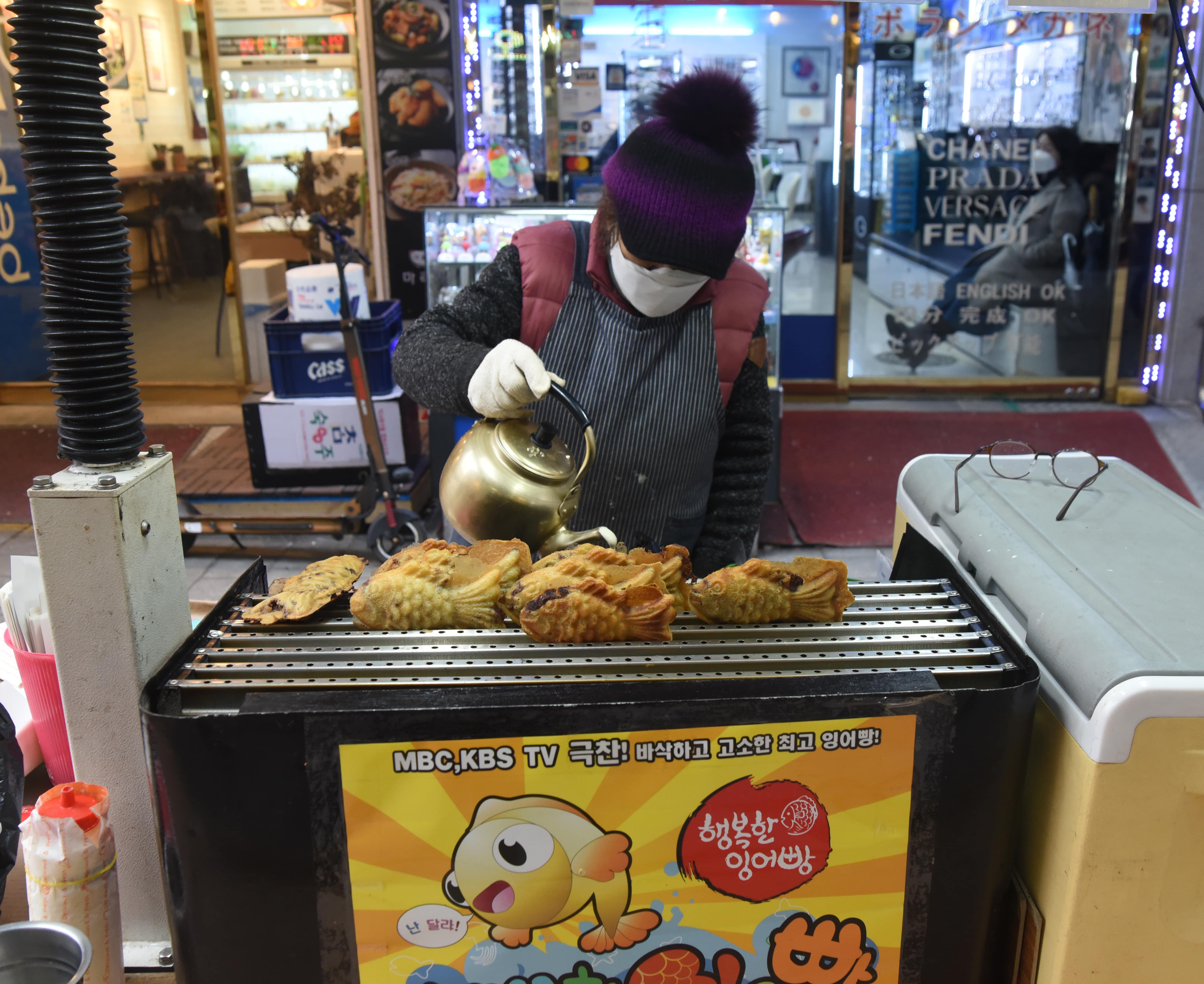[Jan] In winter, Korean street food is life
Date Jan 24, 2022
 A woman makes bungeo-bbang, a carp-shaped piece of bread stuffed with red bean paste, in Namdaemun, January 15. Courtesy of Jon Dunbar
A woman makes bungeo-bbang, a carp-shaped piece of bread stuffed with red bean paste, in Namdaemun, January 15. Courtesy of Jon Dunbar
It's a cold winter day, with temperatures hovering around freezing. And in Namdaemun Market in central Seoul, dozens of people are lined up all around the block. For what? For hotteok, a flat, grilled pastry filled with brown sugar, honey and cinnamon – or sometimes even green tea.
Koreans are up for street food anytime, and cold weather is not about to stop them. Numerous carts, tents, trucks and stalls are found throughout the city dispensing a variety of warm treats. Up the alley from the hotteok stand, a woman uses a pleasingly hot cast-iron mold to make bungeo-bbang (a carp-shaped piece of bread stuffed with red bean paste). Looking further into the complex alleys of the market district, street food vendors are offering walnut cakes, steamed corn and roasted sweet potatoes.
Dalgona vendors are enjoying new-found popularity after their candy made of melted sugar and baking soda made an unforgettable impression during an episode of Netflix’s hit series "Squid Game." The brittle dalgona treats are embedded with the outline of simple shapes. Customers try to break off the exterior bits and free an intact star or whatever shape the vendor made with a mold. Rather than punishing those who fail, dalgona sellers reward success, usually in the form of a free dalgona.
Korean street food is ever-changing as new trends come and new ingredients are discovered. A few blocks away in more youth-oriented Myeong-dong, a young man is selling deep-fried delicacies, including jumbo shrimp and "potato twists," a whole potato bizarrely sliced into a spiral stretched out over a half-meter-long skewer. Around the corner, a young woman is selling croffles (a croissant-waffle combination) out of a cart. The offerings never stop in Korea's street food scene.
More and more foreign foods are appearing. Adnan, an Iraqi who left his home country in 2006, has been serving up kebabs, falafel and other halal street food from a stall since 2008. On this day, his 20-year-old son is manning the vertical spit used to slowly cook pieces of chicken. He grew up in Korea, went to school here and speaks Korean almost as well as his native Arabic.
As night approaches, the markets start to close up for the day, and many of these street vendors start packing up too. But not all, as the area around Jongno and Dongdaemun Market begins to fill with pojangmacha, cart restaurants that spread out under large tents and canopies. They invite people in to sit down, enjoy their warmth, have a few drinks and stay for a meal, such as fried seafood, pig trotters and buchimgae (pan-fried fritters). A popular destination for a proper sit-down street-food meal is Gwangjang Market near Jongno 5-ga Station. This open-air market lies under a permanent canopy and is famous for its “bindaetteok” (mung bean pancake) and mayak gimbap (literally “narcotic gimbap”), so named because just one of these mini gimbap rolls can get you hooked.
Korea’s street food scene showcases the inventiveness and trendiness of the country’s culture. Enjoy it now: Today’s inexpensive roadside snack might be tomorrow’s high-end dining experience.
**If you have any questions about this article, feel free to contact us at kocis@korea.kr.**

The Ministry of Culture, Sports and Tourism's "Korea Here & Now" work can be used under the condition of "Public Nuri Type 1 (Source Indication)."




